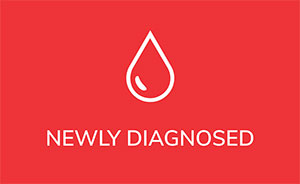
By Adrian Wiestner, MD, PhD
In 1928, Dr. Richter described a patient with chronic lymphocytic leukemia (CLL), who progressed to develop an aggressive large cell lymphoma. Richter syndrome (RS), also called Richter transformation, is now understood to describe the development of an aggressive lymphoma in patients with CLL or small lymphocytic lymphoma (SLL). The aggressive lymphoma in RS is most often of the diffuse large B cell type and less commonly appears as Hodgkin lymphoma. In the majority of cases, the RS evolves from a CLL cell that acquired additional genetic events. Uncommonly, RS arises independently of the CLL clone, i.e. from a different (non-CLL) B cell.1,2
The rate of RS reported in the literature is quite variable, affecting between 2 and 10% of patients with CLL. While sometimes considered to be a late event, more recent reports suggest that about half of the RS cases are recognized between 2 and 4 years from CLL diagnosis. RS can develop in previously untreated patients with CLL or be recognized when patients progress during or after their CLL-directed treatment.
The diagnosis of RS requires analysis of tissue, typically from a lymph node or bone marrow biopsy. RS appears as an aggregation of cells that are larger than typical CLL cells. Areas of RS and CLL can be present in the same biopsy. It is also possible to have RS only in some lymph nodes, while others may still show typical CLL / SLL. This is one of the rare occasions where PET scans may be helpful in CLL as PET scans can help identify lymph nodes suspicious for RS.3 Signs indicating the possibility of RS include rapid growth of lymph nodes and high or rapidly rising levels of LDH, a blood test.
The risk of developing RS seems to depend on genetic factors in the CLL cell. RS may be more common in CLL with deletion 17p, or trisomy 12 or NOTCH1 mutation or in CLL expressing specific types of B-cell receptors, referred to as “stereotyped”.2,4 Overall, most cases of RS arise in the CLL subtype expressing unmutated IGHV genes. The IGHV (immunoglobulin heavy chain variable) gene encodes part of the B-cell receptor on CLL cells. Signals from the B-cell receptor promote CLL progression and these can be inhibited by kinase inhibitors such as ibrutinib and idelalisib.
To what degree the risk of RS is influenced by specific types of treatment is controversial. It is difficult to assess how different treatments affect the rate of RS outside of randomized comparative studies because disease characteristics greatly influence the risk of developing RS. Further, the rate at which RS is diagnosed depends on whether or not lymph node and/or bone marrow biopsies are obtained when patients progress. These considerations may be particularly important when comparing novel therapies to historic control groups.
In early studies with ibrutinib, RS seemingly accounted for many of the progression events. In our study at the NIH using ibrutinib for high-risk CLL with deletion 17p, 5 of 50 patients (10%) progressed at a median follow-up of 2 years.5 Among those five patients, three (6% of all patients) had RS. In comparison, MD Anderson Cancer Center reported RS in 23% of patients with CLL with deletion 17p after a median of 12 months from their first treatment, most often with FCR.4 With longer follow-up on ibrutinib, it is notable that the appearance of RS seems limited to the first 1-2 years of treatment, suggesting that the risk of developing RS is already present when treatment with ibrutinib is initiated.6
In most cases, RS does not respond well to chemotherapy and is often associated with short survival.2 The outlook is somewhat better for patients with the Hodgkin-type RS or when the aggressive lymphoma arises independently, i.e. not from a CLL cell. The most common regimen used to treat patients with aggressive large B cell lymphoma, is R-CHOP, a combination of rituximab with cyclophosphamide, doxorubicin, vincristine, and prednisone. Unfortunately, the results with R-CHOP in RS are unsatisfactory in that most patients have only short-lived responses. Chemotherapy regimens that are more intense than R-CHOP appear not to be more successful but add toxicity.2 Recent treatment strategies that recruit T cells to attack RS appear promising. In particular, the so-called checkpoint inhibitors (pembrolizumab or nivolumab) or chimeric antigen receptor modified T cells (CAR T cells) have achieved good responses in some patients with RS. Clinical trials investigating these treatments are ongoing and are registered at www.clinicaltrials.gov under the identifiers: NCT02332980 (with pembrolizumab); NCT02420912 (with nivolumab); or with CAR T cells as NCT01865617, NCT00466531, and NCT02631044.
In summary, RS is a serious and difficult-to-treat complication of CLL that affects a minority of patients. Recent progress in CLL therapy offers hope that the rate of RS could decline and that patients with RS may soon have more effective therapies available. Participation of patients with high-risk CLL or RS on clinical trials can accelerate progress and, in many cases, offer the best available treatment option.
Adrian Wiestner, MD, PhD is an attending physician at the Hematology Branch, National Heart, Lung, and Blood Institute and a senior investigator in the Laboratory of Lymphoid Malignancies, all within the National Institutes of Health.
Adrian Wiestner, MD, PhD
Bld 10, CRC 3-5140
10 Center Drive
20892-1202 Bethesda, MD
[email protected]
Acknowledgments
The author is supported by the intramural program of the NHLBI, NIH.
Disclosure of Conflicts of Interest
The author received research funding from Pharmacyclics, an Abbvie company, and Acerta Pharma.
References and suggested further reading
- Jamroziak K, Tadmor T, Robak T, Polliack A. Richter syndrome in chronic lymphocytic leukemia: updates on biology, clinical features and therapy. Leuk Lymphoma. 2015;56(7):1949-1958.
- Parikh SA, Kay NE, Shanafelt TD. How we treat Richter syndrome. Blood. 2014;123(11):1647-1657.
- Falchi L, Keating MJ, Marom EM, et al. Correlation between FDG/PET, histology, characteristics, and survival in 332 patients with chronic lymphoid leukemia. Blood. 2014;123(18):2783-2790.
- Strati P, Keating MJ, O’Brien SM, et al. Outcomes of first-line treatment for chronic lymphocytic leukemia with 17p deletion. Haematologica. 2014;99(8):1350-1355.
- Farooqui MZ, Valdez J, Martyr S, et al. Ibrutinib for previously untreated and relapsed or refractory chronic lymphocytic leukaemia with TP53 aberrations: a phase 2, single-arm trial. Lancet Oncol. 2015;16(2):169-176.
- Maddocks KJ, Ruppert AS, Lozanski G, et al. Etiology of Ibrutinib Therapy Discontinuation and Outcomes in Patients With Chronic Lymphocytic Leukemia. JAMA Oncol. 2015;1(1):80-87.
Originally published in The CLL Tribune Q4 2016.

















